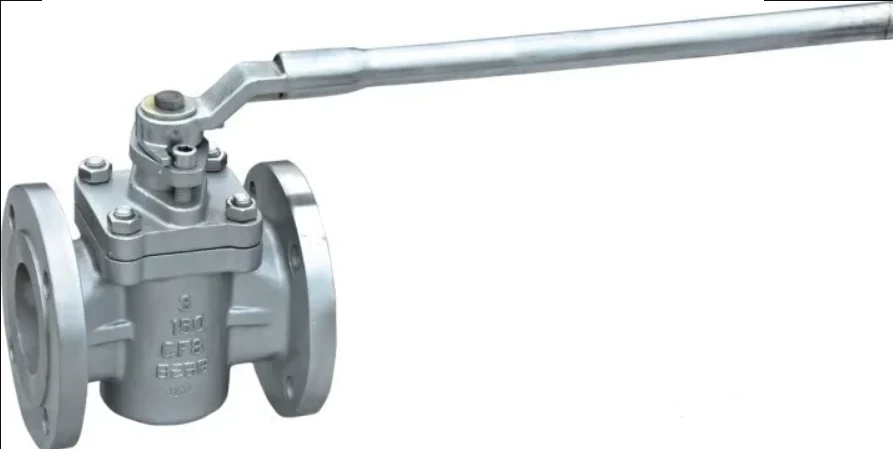Commonly Used Valves in Natural Gas Pipelines - Plug Valve
Commonly Used Valves in Natural Gas Pipelines - Plug Valve

The pipeline plug valve is a shut-off valve used in long-distance natural gas pipelines and station control systems, specially designed to meet the unique requirements of natural gas pipelines. It is expected to withstand harsh environments, have a service life exceeding 30 years, offer bi-directional zero leakage, be fire-resistant and anti-static, resist acidic medium corrosion, and require minimal operating force, among other specialized technical features. Currently, all plug valves used in domestic natural gas pipelines and station control systems are imported inverted balanced oil-sealed plug valves.
Features and Working Principle of the Plug Valve Structure
The inverted balanced oil-sealed pipeline plug valve adopts an inverted valve core pressure-balanced oil-sealed structure. It consists of the body, bonnet, stem, plug body, coupling balance ring, stem sealing assembly, and mounting parts.
1.Valve Body
The valve body is constructed in an inverted bell shape, cast as a single piece for high strength and rigidity, with even force distribution. The body and the valve's center of mass are essentially aligned with the pipeline center, providing stable operation. The conical sealing surface of the body undergoes high-speed fine grinding and is polished to achieve a surface roughness of less than Ra0.8.
2.Plug
The plug is an inverted-style, integrally forged plug. After precision machining and grinding, it achieves a surface roughness of up to Ra0.4. The plug's surface undergoes treatments such as nitriding, nickel-phosphorus alloy plating, or hard alloy spraying to enhance surface hardness. The surface hardness from high-velocity sprayed hard alloy can reach HRC65 or higher, while nickel-phosphorus alloy plating followed by heat treatment achieves a hardness of HRC58–60. This provides exceptional wear resistance under oil film lubrication.
An integrated check valve on the upper part of the plug compensates for the injection pressure in the upper chamber, while a balance hole on the lower part allows the medium pre

3.Friction Pair
The sealing pair uses a metal-sealed structure with grease sealing. The grease fills and occupies the sealing space, effectively preventing solid particles in the medium from entering the sealing surface, thus offering excellent protection. The grease provides lubrication, minimizing operating torque and making the valve easy to operate. The special asymmetrical oil groove design ensures that grease is automatically applied without leakage as the plug rotates, fully maintaining the integrity of the oil film and ensuring reliable sealing. This design minimizes oil loss, extending the grease refill interval and usage period. The conical surface sealing has a large contact area, ensuring long service life with oil film lubrication.
4.Stem and Stem Sealing
The strength and sealing performance of the stem are key factors affecting operation and overall valve performance. The stem is subjected to forces primarily from friction at the packing, operational torque, and medium thrust. The stem and plug are connected via a sliding ring, which reduces concentricity errors between the stem center and the plug’s conical surface, enhancing operational performance. The stem has an anti-ejection design, allowing for online replacement of packing seals. The stem sealing utilizes a triple-seal design with fireproof packing, an O-ring, and grease injection. After machining, the stem surface achieves a roughness of Ra0.4, meeting stringent sealing requirements for reliable, maintenance-free operation. The stem is integrally forged and tempered for high strength and toughness, with nitriding or nickel-phosphorus alloy plating for a high-hardness, wear-resistant surface.
5.Bonnet and Bottom Structure
Compared with traditional bushing-type plug valves, this pipeline plug valve offers the following features:
1)Reliable sealing and long service life: The plug valve achieves sealing through its conical surface, with a large sealing contact area, where the oil film serves both lubrication and sealing purposes. Grease injection sealing uniformly applies sealing grease to the sealing surface during the plug’s opening and closing movement, effectively lubricating the sealing surface. Additionally, due to the filling and wiping effect of the sealing grease, solid particles in the medium do not enter the sealing pair, and the fully open position prevents contact with the flowing medium, effectively protecting the sealing pair.
2)Low torque and easy operation: The inverted installation method of the plug cone balances the pressure in the valve’s lower chamber with the medium pressure in the pipeline at the instant of opening, pushing the plug body tightly against the inner cone surface of the valve body. High-pressure oil in the upper chamber pushes downwards on the plug body, balancing the force on the top and bottom ends of the plug cone and reducing the effort needed for rotation.
3)Adjustable support on the bottom cover: An adjustment support is installed on the bottom cover of the valve body to adjust the position of the valve core. In high-temperature conditions, the thermal expansion of the plug can be absorbed through its vertical movement, preventing the sealing pair from becoming wedged. This device also has the function of discharging static electricity that may be generated by friction between the valve core and the medium.
4)The same function with floating ball valve,anti-blowout design for the valve stem: The valve stem has a triple-seal design consisting of O-rings, graphite packing, and injected sealing grease, meeting leakage requirements, and enabling long-term reliable operation with fire-resistant functionality, similar to the fully welded ball valve described earlier.
 +86 512 68781993
+86 512 68781993 


















